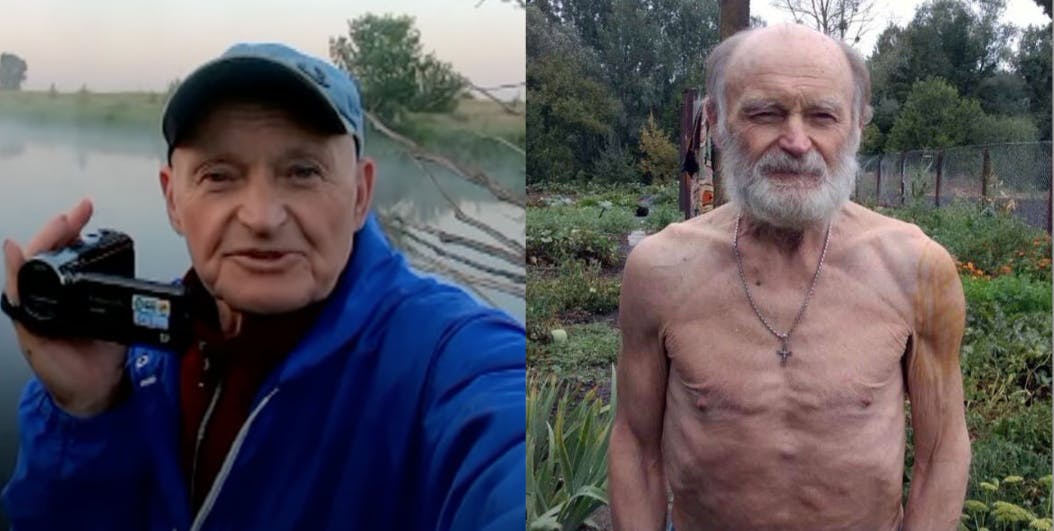Ukrainian vlogger reveals how he was arrested tortured for posting Russian troop movements to YouTube

Three weeks after Anatoly Gargaty posted a video on his YouTube channel of Russian tanks parading through the streets of his village, he was hiding from Russian soldiers after they appeared at his door.
His neighbors had warned him against recording the violence of life under Russian occupation in Saventsy, Ukraine, but he had ignored their concerns.
Minutes after arriving, Russian soldiers found Gargaty in his garage, he claimed, throwing him to the floor and beating his arms and legs, he said in an interview with the Daily Dot.
He was arrested—as his wife Natalia watched helplessly—for being an informant for Ukraine’s armed forces, accused of recording Russian military activity and posting it on YouTube. For the next 100 days, he would be tortured in a Russian prison for using social media to display Russia’s war crimes.
One year later, Gargaty spoke with the Daily Dot about how, in posting videos of Russia’s invasion on YouTube, he became a victim of them in the process.
Anatoly Gargaty, 70, has loved the world of cameras his entire life. Growing up in Savensty, a small village in Kharkiv Oblast, he would take pictures of soccer matches on film cameras. Later, his passion turned into a career, where he shot weddings and school graduations in his hometown. As technology progressed, so did Gargaty’s relationship with cameras. He began working as a video operator in 1992, the year after the collapse of the Soviet Union, and in December 2021, he created a YouTube channel.
At first, the channel showed what he had collected during his 50-year-long photography career, and it had just ten subscribers.
But after Russia’s February 24, 2022, invasion of Ukraine, Gargaty’s YouTube channel accumulated more traction as he uploaded videos of Russian military activity. According to Natalia Ostapchuik, a spokesperson for Savensty’s government, uploading videos of life under occupation made Gargaty a clear target for the invading force, which forbids any documentation of military activity.
Kharkiv is the second-largest city in Ukraine. Just under 25 miles away from the Russian border, it became a vicious battleground immediately following the invasion.
Russian forces occupied 32 percent of the entire region during the first few months of the war, according to Oleh Syniehubov, head of the Kharkiv Oblast Military Administration.
At least 1,019 civilians were killed and 1,947 injured in the region from late February to the beginning of August. In addition, according to the International Organization for Migration (IOM), 28% of the 6.8 million internally displaced Ukrainians fled from the Kharkiv region.
As Ukraine became a vicious battleground, Gargaty became a war documentarian, collecting interviews from civilians who decided to stay and filming Russian military vehicles.
Gargaty recalled that “On March 3, the first convoy of Russian equipment passed through my city. I filmed it on video from the window of my house since it is located on the main street. I posted it on YouTube on my channel. I felt like real hero despite the fact that it was scary.”
“My neighbors and acquaintances knew what I was doing and very often asked me not to do it. And they did not approve of my actions,” he added.
During the first three months of Russia’s war, Gargaty used YouTube as a form of citizen journalism, a way to show the world the realities of the Russian occupation. He claimed that he was warned by neighbors to delete all of his YouTube videos related to the war, which he did one day in late April 2022.
But erasing all traces of the war from his social media did not prevent Russian troops from appearing at his house. On May 28, 2022, Gargaty said Russian soldiers, “Came to my house, turned the whole house over, and took away all the technical equipment, computers, gold. After that, I was taken to a garage, where a Russian investigator arrived and began interrogating me. He said that I was an informant for the Ukrainian army.”
“They tortured me with electric shock until I lost consciousness. After that, I was taken to Balanley,” a nearby village, where Gargaty said he was then placed in prison.
“They forced me to sign a paper stating that I was an informant for the Ukrainian army. They threatened to shoot me and promised to help if I got involved in Russian propaganda and worked for them. Which I refused,” he added.
Russia’s war crimes in Ukraine have been one of the focal points of the war, often broadcasted on social media for the entire world to witness.
There were at least 621 cases of enforced disappearances and arbitrary detention of civilians by Russian armed forces calculated in six months before January 31, 2023, according to a statement by Matilda Bogner, the head of the UN Human Rights Monitoring Mission in Ukraine.
“In occupied areas of Ukraine, we have documented summary executions and attacks on individual civilians by Russian armed forces and the pervasive use of arbitrary detention and enforced disappearances,” said Bogner in the report.
“Among the 127 that we interviewed after their release, 90 percent reported that members of the Russian security forces tortured and ill-treated them while in detention,” she added.
According to Gargaty, once he arrived at the prison in Balanley, he was forced into a holding cell with eight other men, where he lived for 100 days.
“There was no sunlight at all. I could see the sunlight only through the [bathroom] window,” Gargaty said. He was taken from his prison cell to the bathroom every morning, an escape from the cell he shared with other prisoners.
Gargaty said he found ways to hold onto his identity, like maintaining his seven-year-long vegetarian diet, refusing to eat the meat he was given, and reaching through the bathroom window each day to pick fresh grapes from a vine to add to meals.
Adhering to his diet was one thing Gargaty could control in a time when everything was turbulent, where he was punished even for speaking his native language. He claimed that Russian soldiers tortured him in prison on eight separate occasions, each time lasting around two hours.
“Wires were connected to me, and every time I said words in Ukrainian, I was shocked. It was ‘lessons of the Russian language.’ They constantly frightened me with bullets and showed me a wall with blood and tears from bullets. I was scared,” said Gargaty.
Gradually Gargaty began to resemble a shell of his former self. Before being arrested, the 70-year-old was clean-shaven, with a smile on his face as he worked with his cameras and his social media hobby. But over the course of his imprisonment, Gargaty had lost a substantial amount of weight. An image sent to the Daily Dot shows skin pulled taut around the 70-year-old's rib cage, which protruded from starvation.
In May 2022, Ukraine’s military began gradually forcing Russian forces out of the area, pushing them back across the border of the two countries. After Ukraine launched its rapid counteroffensive on Sept. 6, 2022, some 502 settlements in the Kharkiv region were liberated. Balanley was reclaimed by Ukrainian forces on Sept. 8.
Gargaty said he was let go four days before Balanley was liberated. At the time, Gargaty said he had no phone or money and got a ride home from another former prisoner. Once the car arrived in his front yard, his wife and children came out to meet him, in tears that he had finally returned.
Though finally back with his wife, and their two adult children, Vladislav and Svitlana, Gargaty’s world was left shattered by Russian soldiers, who had destroyed all his cameras, recording devices, and laptop, leaving him unable to carry on with the work he had dedicated his life to.
Just hours after returning home, Gargaty began to look for ways to start working on his YouTube channel again. He asked a friend to loan him an old spare camera and laptop that were not being used, anything that would help him restart his work.
In the following days, Gargaty began to create new videos, this time showing life in the liberated Saventsy, where community members were working to rebuild their homes and willing to share their experiences under Russian occupation.
One video that Gargaty posted last month showed how farmers in the nearby Izium region were coping with the destruction of war. The video has accumulated over 225,000 views.
But the 70-year-old YouTuber experiences constant setbacks from the outdated technology, which replaced the three cameras and computers he once had. Gargaty has received three laptops since September, and each has broken.
“At the moment, I am determined to continue working. I have a lot of energy, a lot of ideas. Even though I don’t have the equipment, I am sure that I will be able to find [it] and continue to work for Ukraine,” said Gargaty.
“I still have not been able to recover from the emotional trauma, and I feel that this heartache will stay with me forever. But the most important thing is my desire to work because, for me, it is my whole life,” he added.
Sergio Grekov contributed to the reporting.
Sign up to receive the Daily Dot’s Internet Insider newsletter for urgent news from the frontline of online.
The post Ukrainian vlogger reveals how he was arrested, tortured for posting Russian troop movements to YouTube appeared first on The Daily Dot.
dailynoti coindeskcrypto cryptonewscrypto bitcoinmymagazine mybitcoinist cryptowithpotato mycryptoslate fivenewscrypto findtechcrunch journalpayments nulltxcrypto newsbtcarea




Post a Comment